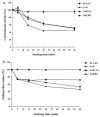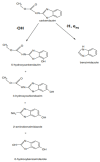Application of Pinhole Plasma Jet Activated Water against Escherichia coli, Colletotrichum gloeosporioides, and Decontamination of Pesticide Residues on Chili (Capsicum annuum L.)
- PMID: 36140988
- PMCID: PMC9498241
- DOI: 10.3390/foods11182859
Application of Pinhole Plasma Jet Activated Water against Escherichia coli, Colletotrichum gloeosporioides, and Decontamination of Pesticide Residues on Chili (Capsicum annuum L.)
Abstract
Plasma activated water (PAW) generated from pinhole plasma jet using gas mixtures of argon (Ar) and 2% oxygen (O2) was evaluated for pesticide degradation and microorganism decontamination (i.e., Escherichia coli and Colletotrichum gloeosporioides) in chili (Capsicum annuum L.). A flow rate of 10 L/min produced the highest concentration of hydrogen peroxide (H2O2) at 369 mg/L. Results showed that PAW treatment for 30 min and 60 min effectively degrades carbendazim and chlorpyrifos by about 57% and 54% in solution, respectively. In chili, carbendazim and chlorpyrifos were also decreased, to a major extent, by 80% and 65% after PAW treatment for 30 min and 60 min, respectively. E. coli populations were reduced by 1.18 Log CFU/mL and 2.8 Log CFU/g with PAW treatment for 60 min in suspension and chili, respectively. Moreover, 100% of inhibition of fungal spore germination was achieved with PAW treatment. Additionally, PAW treatment demonstrated significantly higher efficiency (p < 0.05) in controlling Anthracnose in chili by about 83% compared to other treatments.
Keywords: chili (Capsicum annuum L.); cold plasma; decontamination; pesticides; pinhole plasma jet; plasma activated water.
Conflict of interest statement
Authors declare no conflict of interest and the funders had no role in the design of the study.
Figures












Similar articles
-
Antifungal effect of volatile organic compounds produced by Streptomyces salmonis PSRDC-09 against anthracnose pathogen Colletotrichum gloeosporioides PSU-03 in postharvest chili fruit.J Appl Microbiol. 2021 Sep;131(3):1452-1463. doi: 10.1111/jam.15037. Epub 2021 Mar 5. J Appl Microbiol. 2021. PMID: 33570812
-
Final report on the safety assessment of capsicum annuum extract, capsicum annuum fruit extract, capsicum annuum resin, capsicum annuum fruit powder, capsicum frutescens fruit, capsicum frutescens fruit extract, capsicum frutescens resin, and capsaicin.Int J Toxicol. 2007;26 Suppl 1:3-106. doi: 10.1080/10915810601163939. Int J Toxicol. 2007. PMID: 17365137 Review.
-
Efficacy of Different Decontamination Processes in Mitigation of Pesticide Residues from Chili Crop.J Food Prot. 2021 May 1;84(5):767-771. doi: 10.4315/JFP-20-413. J Food Prot. 2021. PMID: 33290555
-
Identification, prevalence and pathogenicity of Colletotrichum species causing anthracnose of Capsicum annuum in Asia.IMA Fungus. 2019 Jun 28;10:8. doi: 10.1186/s43008-019-0001-y. eCollection 2019. IMA Fungus. 2019. PMID: 32355609 Free PMC article.
-
Application of plasma-activated water in the food industry: A review of recent research developments.Food Chem. 2023 Mar 30;405(Pt A):134797. doi: 10.1016/j.foodchem.2022.134797. Epub 2022 Nov 1. Food Chem. 2023. PMID: 36371834 Review.
Cited by
-
Advancements in Plasma Agriculture: A Review of Recent Studies.Int J Mol Sci. 2023 Oct 11;24(20):15093. doi: 10.3390/ijms242015093. Int J Mol Sci. 2023. PMID: 37894773 Free PMC article. Review.
-
Degradation of Pesticide Residues in Water, Soil, and Food Products via Cold Plasma Technology.Foods. 2023 Dec 6;12(24):4386. doi: 10.3390/foods12244386. Foods. 2023. PMID: 38137190 Free PMC article. Review.
-
Enhancing postharvest food safety: the essential role of non-thermal technologies in combating fungal contamination and mycotoxins.Front Microbiol. 2025 Mar 11;16:1543716. doi: 10.3389/fmicb.2025.1543716. eCollection 2025. Front Microbiol. 2025. PMID: 40135060 Free PMC article. Review.
-
Comparison of plasma technology for the study of herbicide degradation.RSC Adv. 2023 May 15;13(21):14078-14088. doi: 10.1039/d3ra00459g. eCollection 2023 May 9. RSC Adv. 2023. PMID: 37197673 Free PMC article.
References
-
- Tiffany Hot Stuff: What Are the Different Thai Chilies? [(accessed on 20 April 2022)]. Available online: https://www.foodrepublic.com/2016/08/31/hot-stuff-what-are-the-different...
-
- Thai-PAN The Thailand Pesticide Alert Network. [(accessed on 20 April 2022)]. Available online: https://www.thaipan.org/highlights/2283.
-
- Lacap A.T., Photchanachai S., Bayogan E.R.V., Wongs-Aree C., Pongprasert N. Reduction of chlorpyrifos residues in ‘super hot’ chili (Capsicum annuum L.) fruit using washing agents. Philipp. J. Sci. 2021;150:237–244.
-
- World Health Organization (WHO) Food Safety: Pesticide Residue. [(accessed on 22 April 2022)]. Available online: https://www.who.int/news-room/questions-and-answers/item/food-safety-pes....
Grants and funding
LinkOut - more resources
Full Text Sources
Research Materials

